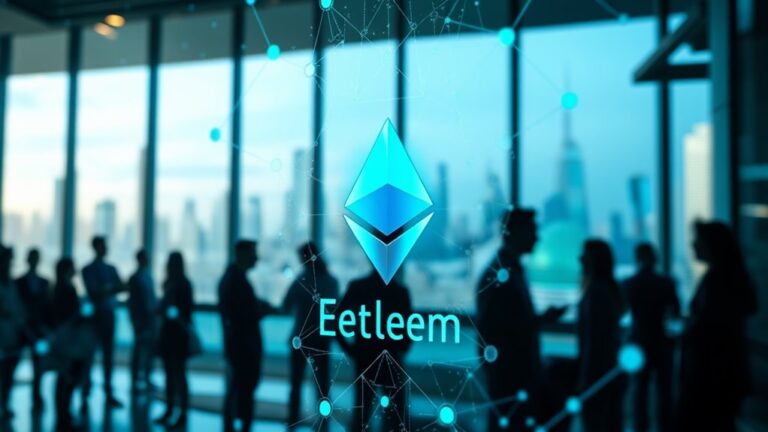
History of Ethereum: An Essential Evolution Timeline
Ethereum launched in 2015 after Vitalik Buterin’s vision and a successful crowdsale. The network faced a critical challenge with the DAO hack in 2016, resulting in a contentious fork. 2017 brought the ICO boom, followed by market volatility and scaling issues in 2018-2019. The ecosystem evolved dramatically with DeFi’s rise in 2020 and NFT popularity in 2021. The Merge in 2022 transformed Ethereum to proof-of-stake, reducing energy use by 99%. Further exploration reveals Ethereum’s essential impact on blockchain technology.
Key Takeaways
- Ethereum launched in July 2015 after a successful crowdsale, introducing programmable blockchain technology with smart contract functionality.
- The DAO hack in 2016 led to a controversial hard fork, creating Ethereum Classic and establishing critical governance precedents.
- 2017’s ICO boom showcased Ethereum’s potential as thousands of projects raised billions using its ERC-20 token standard.
- DeFi applications exploded in 2020-2021, with total value locked growing from $1 billion to over $13 billion.
- The Merge in 2022 transitioned Ethereum from proof-of-work to proof-of-stake, reducing energy consumption by 99%.
History of Ethereum: An Essential Evolution Timeline

Ethereum’s journey began with its official launch on July 30, 2015, when the genesis block marked the platform’s entry into the blockchain ecosystem. Following a successful crowdsale in 2014 that secured essential funding, the platform quickly established itself as a pioneering force in blockchain technology.
The network underwent significant development phases, starting with the Homestead upgrade in 2016, which enhanced security and stability. However, the same year brought challenges when The DAO hack resulted in a $50 million theft, leading to a controversial hard fork that split the community and created Ethereum Classic.
Subsequent technological advancements included the Byzantium and Constantinople upgrades, culminating in the momentous 2022 Merge, which transformed Ethereum from proof-of-work to proof-of-stake, reducing energy consumption by 99%. This shift to proof-of-stake is expected to enhance Ethereum’s security and scalability, paving the way for future innovations.
The Genesis of Ethereum: Vitalik Buterin’s Vision (2013-2014)

Innovation often emerges from recognizing limitations in existing systems, and in 2013, this principle catalyzed the birth of Ethereum. Vitalik Buterin and a group of developers envisioned a platform that would transcend Bitcoin’s capabilities, creating a “world computer” capable of running programmable applications through smart contracts.
After unsuccessful attempts to modify Bitcoin, Buterin published the Ethereum whitepaper on November 27, 2013, outlining his vision for a Turing-complete blockchain. The project gained momentum in January 2014 when publicly announced at the North American Bitcoin Conference in Miami.
Notable developers like Gavin Wood joined the initiative, contributing to technical specifications. An ICO in mid-2014 raised over $18 million, funding development efforts. This innovative platform ultimately aimed to harness the potential of decentralized applications (dApps) that could revolutionize various industries.
Frontier Launch and Early Network Development (2015)

The summer of 2015 marked a historic milestone in blockchain evolution when Ethereum Frontier, the first public version of the network, launched on July 30 after years of anticipation and development.
Following the Olympic testnet phase, Frontier emerged as a bare-bones, command-line interface mainly designed for developers, not casual users.
Frontier featured a 5 ETH block reward and utilized gas to limit computational resources. The initial gas limit was conservatively set at 5,000 per block to prevent network overload.
Despite its developer-centric approach, Frontier allowed most computers to mine Ether using GPUs, reducing centralization risks.
The network came with clear warnings about potential risks, as it served chiefly as a testing ground for future upgrades, including the anticipated Homestead release. The transition to Proof of Stake in 2022 built upon the foundational work established during Frontier.
The DAO Hack and Ethereum Classic Fork (2016)

What began as an ambitious experiment in decentralized funding ended in one of blockchain’s most consequential crises when hackers struck The DAO in June 2016.
After raising an impressive $150 million from over 11,000 investors, The DAO fell victim to a reentrancy attack that drained approximately 3.6 million Ether ($50-70 million).
The hack created a philosophical divide within the Ethereum community.
After much debate, developers implemented a hard fork to restore stolen funds—effectively altering blockchain history.
Those who prioritized immutability rejected this solution, maintaining the original chain as Ethereum Classic (ETC).
This fork established two separate blockchains: Ethereum, which reversed the hack, and Ethereum Classic, which upheld the “code is law” principle.
The incident prompted critical conversations about smart contract security and blockchain governance, highlighting the importance of DeFi protocols in ensuring the safety of decentralized applications.
ICO Boom and Mainstream Recognition (2017)

Following the Ethereum hard fork in 2016, a tidal wave of tokenization swept through the blockchain ecosystem in 2017 as Ethereum became the platform of choice for Initial Coin Offerings (ICOs).
Projects like Filecoin, EOS, and Tezos conducted record-breaking token sales, collectively raising billions of dollars and capturing mainstream attention.
The explosive growth of unregulated fundraising soon caught the eye of financial regulatory bodies worldwide, setting the stage for increased scrutiny and eventual market correction. This surge in ICOs highlighted the growing trend of cryptocurrency fundraising, which allowed startups to raise capital directly from global investors.
Tokenization Explosion Begins
Innovation sparked an unprecedented era in Ethereum’s history during 2017, as the Initial Coin Offering (ICO) boom catapulted the platform into mainstream recognition.
Ethereum’s smart contract capabilities enabled developers to create and distribute tokens with unprecedented ease, establishing the ERC-20 standard as the industry benchmark. This tokenization explosion transformed Ethereum from a niche blockchain into the primary launchpad for decentralized applications.
- Ethereum became the dominant platform for token creation, with thousands of projects raising billions of dollars through ICOs.
- The ERC-20 token standard emerged as the technical foundation, simplifying token development and integration.
- Regulatory uncertainty initially fueled rapid growth before increasing scrutiny slowed momentum.
- This period drove significant technological innovation, including early NFT development and infrastructure improvements. Furthermore, Ethereum’s capabilities have since expanded into decentralized finance (DeFi), enhancing financial services and providing innovative solutions across various sectors.
Record-Breaking Token Sales
The record-breaking token sales of 2017 propelled Ethereum into mainstream consciousness, as projects raised unprecedented amounts of capital through Initial Coin Offerings.
ERC-20 tokens became the industry standard, simplifying token creation and distribution across hundreds of new projects. Over $5.6 billion was raised in 2017 alone, demonstrating the financial magnitude of this phenomenon.
Notable successes included EOS’s staggering $4.1 billion raise, Filecoin’s $257 million for decentralized storage, and Tezos securing $232 million.
Telegram’s $1.7 billion ICO, though restricted to private investors, highlighted the scale of investor enthusiasm. This fundraising surge dramatically increased Ethereum network activity, driving up Ether’s price and expanding its community.
However, this explosive growth operated in regulatory gray areas, leading to subsequent SEC enforcement actions against several major projects. Furthermore, the need for regulatory clarity became increasingly evident as the market matured, influencing future investment strategies and project development.
Regulators Take Notice
As Ethereum’s ecosystem expanded dramatically throughout 2017, regulatory authorities worldwide increasingly took notice of the burgeoning ICO phenomenon. The SEC began investigating whether these token sales constituted unregistered securities offerings, while international regulators developed their own frameworks to address the rapidly evolving market.
- The U.S. Securities and Exchange Commission issued guidance through the “DAO Report,” establishing that many tokens could be classified as securities.
- Global regulatory bodies implemented varying approaches, from outright bans in some countries to more accommodating frameworks in others.
- Legal scrutiny forced projects to evaluate compliance measures, including KYC/AML procedures.
- Regulatory attention contributed to market corrections as investors became more cautious about potential legal implications.
This regulatory evolution marked a significant turning point for Ethereum-based projects, as the era of unchecked fundraising gave way to increased accountability and compliance requirements. As regulators adapt to the changing landscape, the focus on consumer protection is expected to shape future innovations in the crypto space.
Market Volatility and Technical Challenges (2018-2019)

Following the ICO boom of 2017, Ethereum faced harsh market realities in 2018 as prices fell by more than 90 percent from their all-time high, signaling the beginning of a prolonged bear market.
This dramatic devaluation occurred alongside growing technical challenges, particularly related to blockchain scalability, which limited Ethereum’s transaction processing capacity.
In response, developers began experimenting with various scaling solutions, including state channels, Plasma frameworks, and early planning for the eventual shift to Proof of Stake, which would address both performance limitations and environmental concerns. Additionally, the emergence of Layer 2 solutions provided further avenues for enhancing Ethereum’s scalability and reducing transaction costs.
Bear Market Realities
Between 2018 and 2019, Ethereum experienced one of its most severe bear markets, characterized by a staggering 92-94% drawdown from its all-time high of $1,416. This extended downturn lasted over 1,108 days before recovery, with the Historical In/Out of the Money indicator showing only 3% of addresses remaining profitable.
The market decline reflected broader financial market sentiment while creating significant technical and investment challenges.
- Investor behavior shifted dramatically with widespread panic selling and a move toward more conservative assets.
- Scalability issues and security concerns threatened Ethereum’s competitive position against emerging blockchain platforms.
- The announcement of a shift from Proof of Work to Proof of Stake created uncertainty.
- Regulatory environments tightened globally, further dampening investor confidence.
- Additionally, concerns over smart contract vulnerabilities highlighted the need for improved security measures during this tumultuous period.
Scaling Solution Experiments
While Ethereum continued to establish itself as a cornerstone of blockchain technology, the network faced significant scalability challenges that threatened its long-term viability.
During 2018-2019, the platform’s Layer 1 infrastructure struggled to handle increasing transaction volumes, resulting in network congestion and prohibitively high gas fees.
In response, developers began experimenting with various scaling solutions. Layer 2 technologies like rollups emerged as promising approaches, with Optimistic and ZK variants offering different trade-offs between integration ease and computational requirements.
Projects such as Loom Network and Matic Network contributed valuable innovations to the ecosystem.
Simultaneously, work progressed on the Casper protocol, aimed at converting Ethereum to proof-of-stake consensus to enhance both scalability and energy efficiency.
Interoperability efforts through projects like Cosmos further complemented these scaling initiatives by enabling smoother interactions between different blockchain systems.
DeFi Revolution and Network Upgrades (2020)

The year 2020 marked a watershed moment in Ethereum’s history as the decentralized finance (DeFi) sector exploded into mainstream awareness. Total Value Locked (TVL) surged from $1 billion to over $13 billion by December, representing a staggering 2,000% increase.
However, this rapid growth exposed Ethereum’s scalability limitations, triggering significant network upgrades and development.
- Liquidity mining emerged as a powerful incentive mechanism, with protocols like Compound pioneering new ways to attract users and create market liquidity.
- Decentralized lending platforms such as Aave and Compound revolutionized financial services by removing traditional intermediaries.
- EIP-1559 implementation improved gas pricing mechanisms to address escalating transaction fees.
- Layer 2 solutions including Optimism and Arbitrum were developed to alleviate network congestion while maintaining security.
NFT Explosion and All-Time Highs (2021)

Ethereum’s ecosystem underwent a transformative revolution in 2021 as non-fungible tokens (NFTs) catapulted from niche crypto applications to mainstream cultural phenomena. The market exploded to nearly $41 billion, rivaling the global art market, while NFT funding increased by an astonishing 6,523% from the previous year.
| NFT Milestone | Impact | Value |
|---|---|---|
| Beeple’s “Everydays” | Record-breaking digital art sale | $69 million |
| CryptoPunks | Pioneered digital collectibles | Multiple 7-figure sales |
| NBA Top Shot | Corporate adoption | Mainstream exposure |
| Virtual Real Estate | Expanded NFT use cases | Metaverse integration |
| Fractional Ownership | Democratized access | Shared investment opportunities |
This period also saw Ethereum reach all-time price highs as institutional investors recognized the blockchain’s potential beyond cryptocurrency, particularly for supporting digital ownership verification.
Frequently Asked Questions
How Does Ethereum’s Energy Consumption Compare to Bitcoin?
Ethereum’s energy consumption is considerably lower than Bitcoin’s. After moving to Proof of Stake in 2022, Ethereum uses approximately 0.01 TWh annually, while Bitcoin continues to consume over 176 TWh through Proof of Work.
What Programming Languages Are Used to Develop Ethereum Smart Contracts?
Ethereum smart contracts are primarily developed using Solidity, the most popular language, along with alternatives like Vyper, Yul, and emerging options such as Fe. Each language offers different syntax and security features.
How Has Ethereum Addressed Regulatory Challenges Across Different Countries?
Like a knight maneuvering through different kingdoms, Ethereum has addressed regulatory challenges through the Ethereum Foundation’s engagement with policymakers, implementing KYC/AML protocols where required, and adapting its development approach based on jurisdictional frameworks.
What Roles Do Validator Nodes Play in Ethereum’s Network?
Validator nodes in Ethereum verify transactions, propose new blocks, guarantee network finality, enhance security through decentralization, and stake 32 ETH as collateral. They operate through Proof of Stake consensus and receive rewards for participation.
How Does Ethereum’s Monetary Policy Differ From Traditional Cryptocurrencies?
Ethereum features a dynamic monetary policy with no fixed supply cap, unlike traditional cryptocurrencies. It employs mechanisms like fee burning and validator rewards, allowing supply to adjust based on network activity and security requirements.
Conclusion
Ethereum’s journey mirrors a phoenix rising from digital ash, transforming from a programmer’s vision into a cornerstone of modern finance. Through market storms and technical hurdles, the platform evolved beyond mere cryptocurrency to become the backbone of DeFi and NFT ecosystems. As Ethereum continues its technical metamorphosis, it remains a demonstration of blockchain’s capacity to revolutionize traditional systems while adapting to an ever-changing technological landscape.












